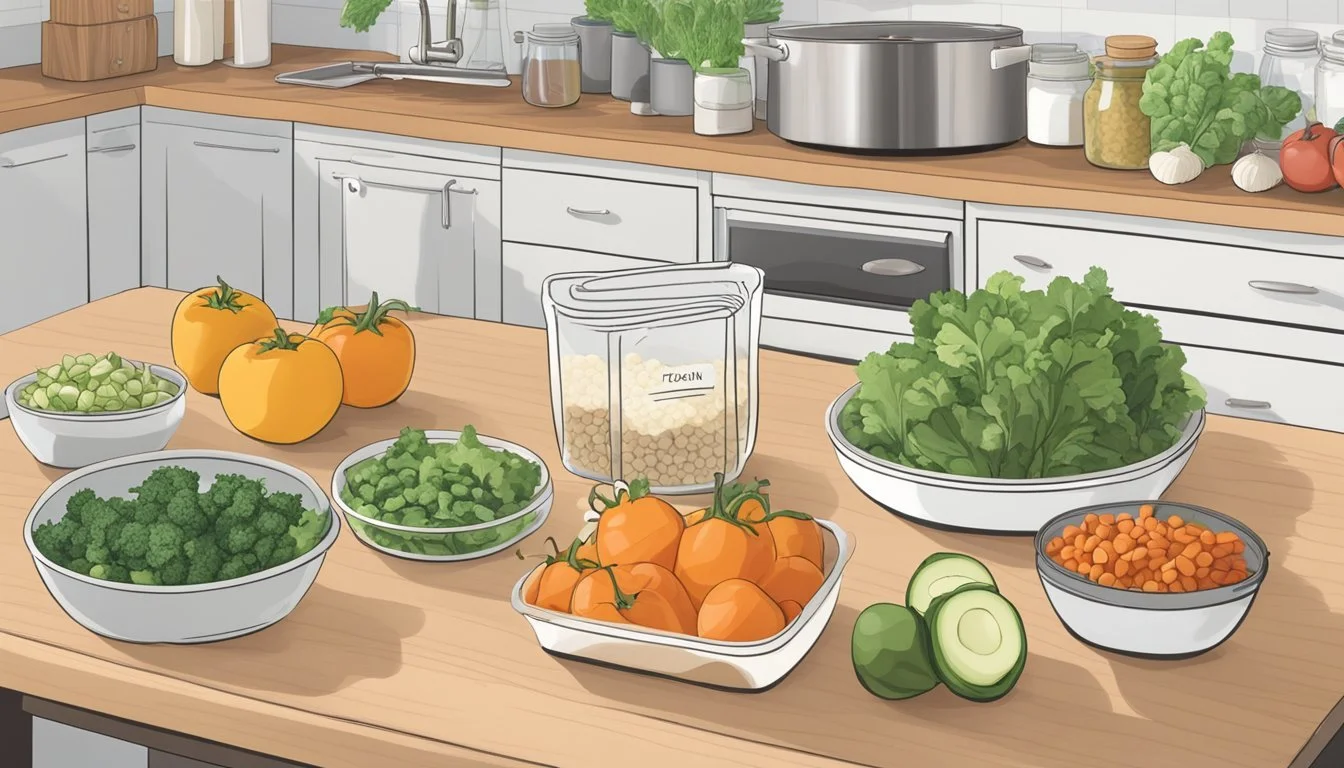Organizing Your Kitchen for a FODMAP Diet
Streamlined Strategies for Digestive Health
Embarking on a low-FODMAP diet involves more than adjusting what one eats; it necessitates a strategic reorganization of the kitchen to align with the diet's requirements. This diet, specifically designed to alleviate symptoms associated with Irritable Bowel Syndrome (IBS), requires individuals to identify and eliminate high-FODMAP foods that may trigger digestive distress. Organizing the kitchen in a manner that supports this dietary approach can help in adhering to the diet effectively and minimizing the potential for errors.
The initial step in tailoring a kitchen to a low-FODMAP diet is the purging of high-FODMAP ingredients that are likely to cause symptoms. Clearing out the pantry and refrigerator of such items simplifies meal preparation and reduces the risk of accidental consumption. It's also important to stock up on low-FODMAP alternatives and arrange them in an easily accessible fashion. This ensures that when it's time to prepare meals, individuals can readily find the ingredients that align with the diet, promoting adherence and culinary enjoyment.
Creating an environment conducive to a low-FODMAP diet aids in sustainable dietary changes and reduces the mental load associated with meal preparation. By investing time in kitchen organization, individuals pave the way for a smoother transition to the diet. Preparation and planning ahead, such as batch cooking and having ready-to-eat low-FODMAP snacks at hand, can also contribute significantly to the success of managing IBS symptoms through dietary modifications.
Understanding FODMAPs and IBS
When organizing your kitchen for a FODMAP diet, understanding the relationship between FODMAPs and irritable bowel syndrome (IBS) is critical. This section breaks down the essentials.
What are FODMAPs?
FODMAPs are a group of carbohydrates that are poorly absorbed in the small intestine. They include Fermentable Oligosaccharides, Disaccharides, Monosaccharides, and Polyols. These short-chain carbohydrates can be found in a wide range of foods, from wheat and beans to dairy products and certain fruits.
How FODMAPs Affect IBS
For individuals with IBS, FODMAPs can lead to increased water in the gut, which often results in diarrhea. Furthermore, they can ferment in the large intestine, causing gas and bloating. Managing the intake of foods high in FODMAPs through a structured diet is a successful strategy for alleviating IBS symptoms for many patients.
The Role of Dietitians in IBS Management
Dietitians play a vital role in supporting individuals with IBS. They provide expert guidance on implementing a low-FODMAP diet, which restricts high-FODMAP foods to identify triggers. Following an assessment, dietitians can tailor dietary plans that include an appropriate balance of nutrients while minimizing IBS symptoms.
Implementing a Low FODMAP Diet
Implementing a low FODMAP diet involves a structured approach starting with an elimination phase, followed by a reintroduction phase, and finally, establishing a meal plan that maintains nutritional balance while keeping symptoms at bay.
Starting the Elimination Phase
The elimination phase is the initial step in a low FODMAP diet where one needs to avoid high FODMAP foods typically for a duration of 2-6 weeks. The primary goal is to achieve symptom relief.
Foods to Avoid: High FODMAP foods such as garlic, onions, wheat, and certain dairy products.
Kitchen Organization:
Remove all high-FODMAP items.
Label shelves for low-FODMAP foods to prevent cross-contamination.
Stock up on grains like quinoa, oats, and rice.
Navigating the Reintroduction Phase
The reintroduction phase aims to identify which FODMAPs one can tolerate.
Approach:
One at a Time: Introduce one high FODMAP food group every three days.
Monitor Symptoms: Keep a food diary to track reactions.
Control Portions: Maintain serving sizes to prevent misinterpreting results.
Tips for Success:
Do not combine FODMAP groups during challenges.
Continue to eat "green light" low-FODMAP foods during this phase.
Creating a Balanced Low-FODMAP Meal Plan
After identifying tolerable FODMAPs, one can create a balanced meal plan that maintains nutrition while minimizing digestive discomfort.
Meal Planning: Plan meals around low-FODMAP staples and reintroduced foods.
Breakfast: Oats with lactose-free yogurt and strawberries.
Lunch: Quinoa salad with grilled chicken and low-FODMAP veggies.
Dinner: Grilled fish with rice and a side of tolerated vegetables.
Grocery Shopping:
Keep a list of safe food items.
Prioritize fresh produce, lean proteins, and whole grains.
By adhering to these steps and incorporating personal tolerance levels, individuals can successfully implement a low FODMAP diet that supports their well-being.
Identifying High and Low FODMAP Foods
When organizing your kitchen for a FODMAP diet, it's important to understand which foods to embrace and which to avoid. A proper categorization helps in managing symptoms associated with irritable bowel syndrome (IBS) and supports a smoother transition to a Low FODMAP diet.
Recognizing High FODMAP Foods
High FODMAP foods contain carbohydrates that may lead to increased water and gas in the intestines, causing discomfort. Here is a list of common high FODMAP foods to be aware of:
Fruits:
Apples
Cherries
Pears
Peaches
Vegetables:
Artichokes
Asparagus
Onions
Garlic
Grains:
Wheat-based products like bread and cereals
Dairy Products:
Milk
Yogurt
Ice cream
Legumes:
Beans
Lentils
Sweeteners:
High-FODMAP sweeteners include those with high fructose content or artificial sweeteners like sorbitol and mannitol.
Selecting Low FODMAP Alternatives
Switching to low FODMAP foods can significantly reduce IBS symptoms. These foods are less likely to cause gas and bloating. Opt for the following low FODMAP options:
Fruits:
Oranges
Grapes
Bananas
Vegetables:
Carrots
Cucumbers
Eggplant
Lettuce
Grains:
Rice
Oats
Meats:
Most unprocessed meats are low in FODMAPs.
Dairy Alternatives:
Lactose-free milk and yogurt
Hard cheeses
Sweeteners:
Maple syrup
Table sugar
In summary, individuals should tailor their kitchen pantry to replace high FODMAP ingredients with these suitable alternatives. For personalized guidance and the most accurate assessment of what foods to choose, they should consult with a dietitian.
Strategies for Kitchen Organization
Organizing a kitchen for a FODMAP diet involves clear labeling, designated cooking spaces, and smart shopping practices. Addressing these aspects ensures the kitchen supports dietary needs while maintaining ease of use and functionality.
Labeling and Storing Foods
One should categorize foods into low and high FODMAP groups. Clear labeling on containers and pantry sections can assist with this organization. Using color-coded labels or stickers can further simplify identification: green for low FODMAP foods and red for high FODMAP items. This can help prevent accidental ingestion of trigger foods. For produce and other perishables, consider dated labels to manage freshness and reduce waste.
Pantry Storage: Separate shelves or bins according to FODMAP content.
Fridge Organization: Use clear, airtight containers to store cut produce and prepared meals.
Preparing FODMAP-Friendly Cooking Spaces
Maintaining a cooking space conducive to a FODMAP diet means having the right tools and areas to prevent cross-contamination with high FODMAP foods. One can dedicate specific cutting boards and utensils for low FODMAP ingredients. Additionally, keeping essential cooking tools like knives and pots within easy reach can streamline the preparation of FODMAP-friendly meals.
Cooking Tools: Store low FODMAP utensils separately.
Preparation Area: Allocate a specific zone on the counter just for low FODMAP meal prep.
Shopping Tips for FODMAP Diets
When purchasing food, one should focus on acquiring fresh, whole ingredients that are low in FODMAPs. Shopping with a list can prevent the temptation to buy high FODMAP foods and ensure that only suitable products enter the kitchen.
Ingredient List: Carry an updated list of low FODMAP foods when shopping.
Shelf Life: Prioritize foods with longer shelf life for less frequent shopping trips, ensuring a steady supply of safe ingredients.
Through these strategic organization practices, individuals can create a kitchen environment that is both conducive to their dietary needs and efficient for everyday use.
Common Challenges and Solutions
In adapting to a FODMAP diet, individuals often face challenges such as managing symptoms, adjusting to dietary restrictions, and maintaining social activities. This section will cover practical strategies to overcome these complications with confidence.
Managing IBS Symptoms and Diet
Individuals with Irritable Bowel Syndrome (IBS) may struggle to align their diets with their symptoms. When organizing a kitchen for a FODMAP diet, it is crucial to:
Identify Trigger Foods: Keep a detailed food diary to track which foods exacerbate symptoms like diarrhea, constipation and abdominal pain.
Stock FODMAP-Friendly Foods: Ensure your pantry is filled with 'safe' foods, reducing the stress of making IBS-friendly choices.
Coping with Bloating, Gas, and Abdominal Pain
Bloating, gas, and abdominal pain are common discomforts for those on a low FODMAP diet. Mitigating these symptoms involves:
Portion Control: Eating smaller meals can help minimize the presence of gas and bloating.
Preparation Techniques: Cooking methods such as grilling and steaming are better for digestion, hence reducing the chances of pain and discomfort.
Dining Out and Social Events on a FODMAP Diet
Maintaining a FODMAP diet during social gatherings or while dining out requires preparation:
Menu Research: Look up menus in advance to find FODMAP-friendly options and communicate dietary constraints with your host or the restaurant.
Safe Snacking: Carry low FODMAP snacks to events to avoid the temptation of high FODMAP foods that may lead to distress.
Supplementary Tips for Success
Successfully managing a FODMAP diet requires a keen understanding of the diet's intricacies, including nutrient variety, fiber intake, and portion sizes. These elements are critical for maintaining both digestive comfort and overall health.
Incorporating a Variety of Nutrients
In a FODMAP diet, it's vital to ensure one gets a variety of nutrients despite the restriction on certain high-FODMAP foods. Monash University advises leaning on low-FODMAP alternatives that still provide necessary vitamins and minerals. For example:
Proteins: Consume eggs and safe meats, avoiding those marinated in high-FODMAP ingredients.
Complex Carbohydrates: Opt for gluten-free grains like rice, quinoa, and oats.
Calcium: Incorporate lactose-free dairy or fortified non-dairy alternatives such as almond milk.
Addressing Fiber Intake
A common challenge when following a low FODMAP diet is getting enough fiber. Here are some fiber-rich, FODMAP-friendly suggestions:
Vegetables: Carrots, eggplant, and potato are good options.
Fruits: Oranges and strawberries can contribute to fiber intake.
Seeds: Chia and linseed are excellent sources of fiber without adding FODMAPs.
Keep portions in check to maintain them within low-FODMAP thresholds.
Understanding FODMAP Food Portions
Portion control is crucial in a FODMAP diet because larger quantities might push a low FODMAP food into a high FODMAP category. It's not just what one eats, but how much. Here's a brief guide to FODMAP food portions:
Vegetables: A half-cup of diced cucumbers is safe, while a whole cup may not be.
Fruits: A medium unripe banana is low FODMAP; however, overripening increases the FODMAP content.
Dairy: Regularly check serving sizes for lactose-free products to remain within safe limits.
By integrating these supplementary tips into their kitchen organization, individuals can navigate the low FODMAP diet with greater ease and success.
Long-Term Management of a FODMAP Diet
Successfully managing a low-FODMAP diet requires a strategic approach that integrates the diet into one's lifestyle, recognizes potential challenges, and utilizes available support and resources for sustaining dietary success.
Adapting the Diet to Your Lifestyle
It's imperative for individuals to tailor the low-FODMAP diet to fit their daily routines to ensure long-term adherence. Creating flexible meal plans that account for personal preferences and schedules can make the diet more manageable. They should consider:
Preparation: Dedicate time each week to prepare FODMAP-friendly meals in advance.
Variety: Incorporate a diverse range of low-FODMAP foods to maintain balanced nutrition and prevent dietary boredom.
Avoiding Common Pitfalls
Awareness of common pitfalls can help individuals maintain their low-FODMAP diet effectively:
Over-Restriction: Avoid unnecessarily strict limitations which may lead to nutritional deficiencies.
Misinformation: Stay informed with accurate FODMAP content lists, as certain foods can be incorrectly labeled as high or low in FODMAPs.
Seeking Support and Resources
Enlisting professional support and utilizing educational resources can greatly enhance the likelihood of a diet's success:
Registered Dietitian: Consult with dietitians specialized in FODMAPs to create personalized meal plans and ensure nutritional adequacy.
Education: Use reliable resources such as books, websites, and patient groups to stay informed about FODMAPs.






